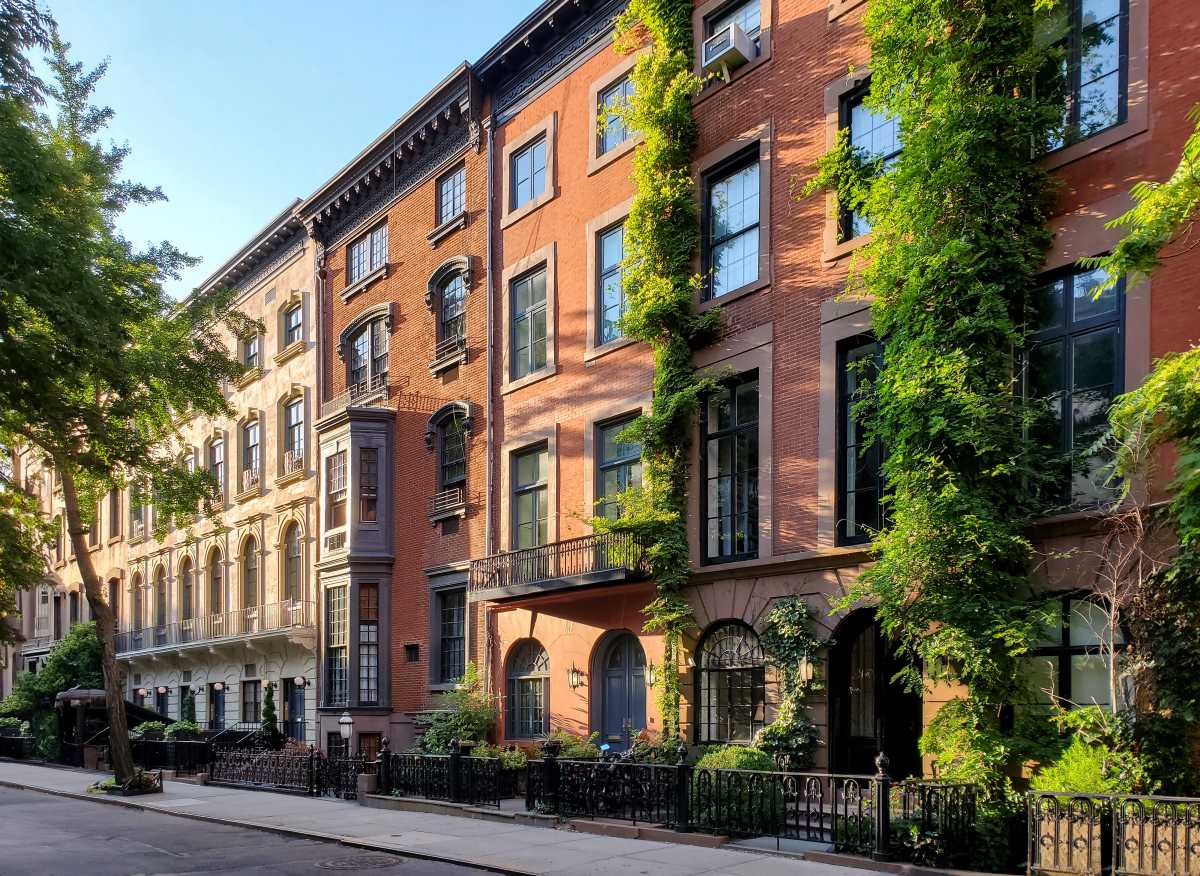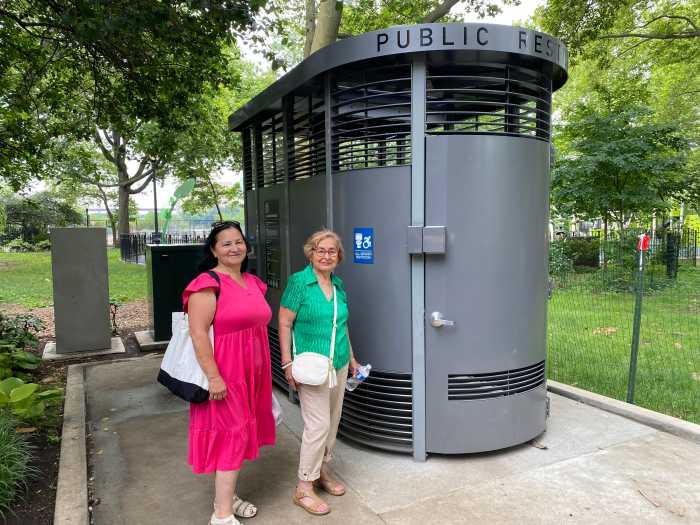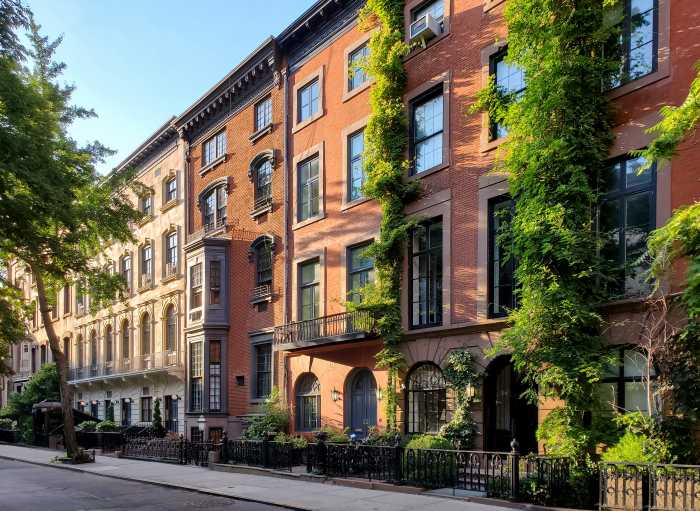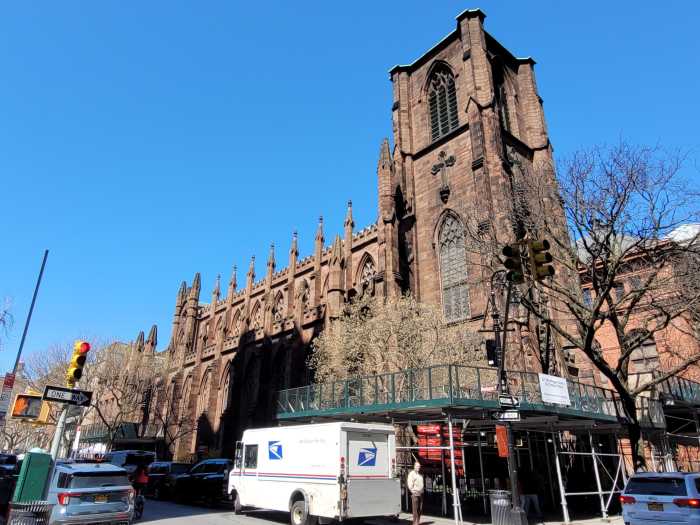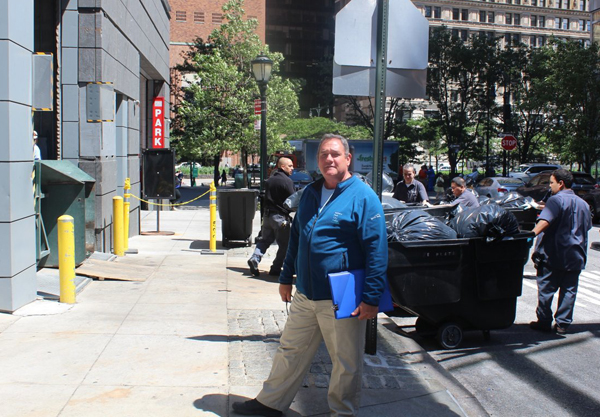
Bruno Pomponio, center, the director of parks operations for the Battery Park City Authority, supervises the daily ritual of workers from the surrounding residential buildings lining up to load the day’s trash to the compactor on Second Pl., the green device on the left. When the dumpster is full, the city sends a truck to pick it up.
BY BILL EGBERT
Finally! A feel-good story about Downtown garbage.
But there may be a solution to the garbage glut — and we can already see it in action right here in Downtown, in Battery Park City.
For the past ten years, most of the residential buildings in the waterfront development have kept their garbage off the curb entirely by transporting it daily to one of several nearby compactors which compress the trash bags to a fraction of their normal size and store all the refuse until specialized Sanitation trucks arrive to haul the entire contraption away to be emptied and returned.
Just one compactor at the southern end of BPC serves eight buildings with a total of 2,021 units. Overall, the four compactors operating in BPC handle all the household garbage generated by more than 7,000 units — more than the 6,537 new units going up across Downtown in the next three years — plus trash from two local schools.
Bruno Pomponio, the director of parks operations for the BPCA, said that a compactor system could be a simple solution to add to the new supertall towers going up elsewhere Downtown that might otherwise be overwhelmed by the trash their residents will produce.
“It would be easy, and it would save space,” said Pomponio, noting that the daily collection means building managers would only have to store one day’s worth of garbage downstairs, rather than letting it pile up for two or three days awaiting curbside collection.
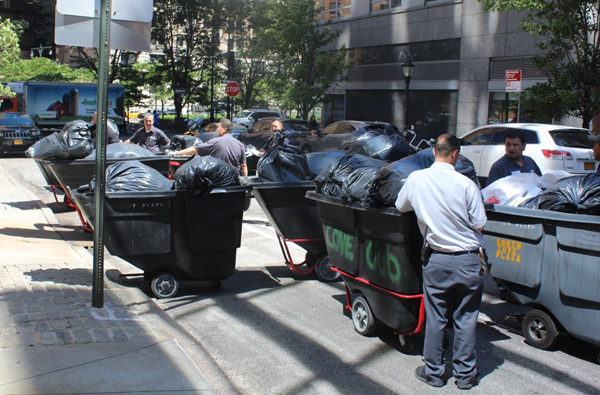
At the compactor at the Battery Park City Parks Conservancy Headquarters, which Pomponio manages, workers from nearby buildings start arriving at about 2:30 each afternoon pushing carts loaded with the same long, black garbage bags that would otherwise be stacked on the curb the day before regular collection. But instead of blocking sidewalks and attracting rats overnight, these garbage bags are tipped into a compactor about eight feet wide and eight feet tall and stretching 23 feet back into the conservancy building. Then a hydraulic piston compresses the refuse to make room for the next cartload. When the compactor unit is full, a Sanitation truck comes to pick it up.
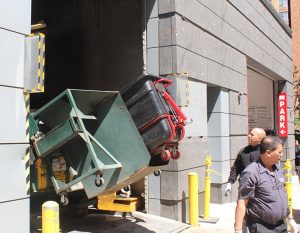
Once the carts are rolled up to the compactor, it tips the contents back into the dumpster, where a hydraulic press compacts the trash to the rear of the container to make room for more.
The entire operation for all eight buildings takes about 90 minutes, and the trash bags never even touch the ground.
The original reason the BPCA adopted the compactor system was to reduce the rat population, which had exploded in the midst of all the construction at the nearby World Trade Center complex, and on that count the program has been “very, very successful,” according to Michael Gubbins, building manager at The Solaire, which led the way in implementing the program in 2006.
“The rat population decreased significantly,” he said. “And without using any pesticides.”
But Gubbins said the compactor program has been a boon to the buildings and their residents in other ways, too.
“You have one truck coming to pick it up, instead of several, which means less traffic,” he said. “You don’t have the garbage piled on the street, and the trucks idling. And you don’t have to clean up after it,” Gubbins said, referring to the scourge of “garbage juice” that plagues sidewalks across Downtown. “That’s a waste of water and unnecessary labor.”
Pomponio added that the Sanitation trucks that pick up the compactors are not the same model as those used for curbside collection, which are drafted into service as snowplows after winter storms. So while garbage bags can pile up for days across the city after a snowstorm, collection continues uninterrupted in BPC.
Gubbins said that Solaire’s experience with the program helped win over the other two dozen BPC buildings that now use compactors.
“We were able to demonstrate to the other buildings how well this works, and they eventually joined in,” he said.
And he said that compactors could be a good way to address the problem of residential garbage piling up in fast-developing areas elsewhere Downtown — especially if nearby buildings joined together like at BPC.
“If you have an area like Downtown where several new buildings are going up, you could have one compactor room serving several buildings,” he said. “It’s well worth exploring.”
The compactor room at the conservancy headquarters is 12-feet wide, 18-feet high, and extends 28-feet in from the building line, and the Dept. of Sanitation trucks would require wider entrances for access on the narrower streets common in the rest of Downtown, so Pomponio conceded that installing a compactor in an existing building could be challenging.
“It’s harder to retrofit a building, but not impossible,” he said.
But it could be worth the money for some of the pricey residential conversions going on in Fidi, such as 70 Pine St., which will bring 644 units — and nearly two tons of daily garbage — to some of the narrowest sidewalks in the city.
In addition to saving ground floor storage space and making trash collection more efficient, a compactor system could even be seen as a competitive advantage for a new luxury building in a tightening market. High-end condominium developments already compete fiercely on amenities — from rooftop pools to world-class restaurants — but who wants to pay millions for a posh pad only to find they have to march past mountains of garbage every other day?
A developer with the foresight to plan for a compactor system could guarantee prospective residents that walking out of their building would always feel just as glamorous as when they walk in.
“It gives the building bragging rights,” said Gubbins. “No garbage on the streets.”




